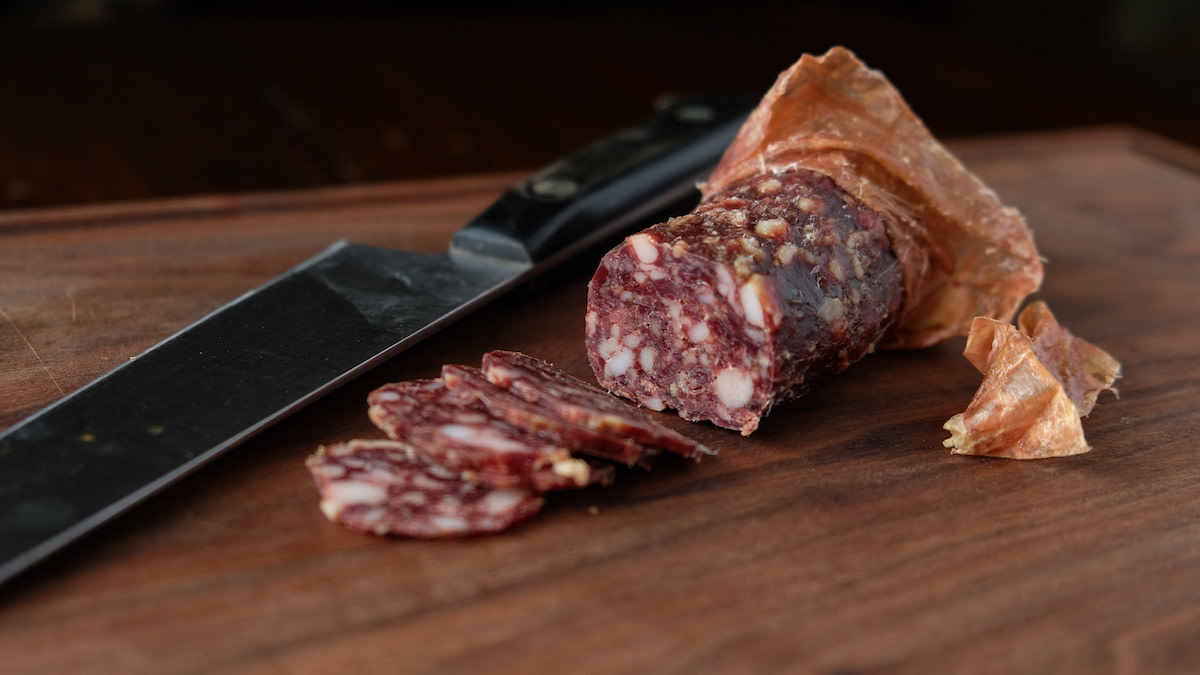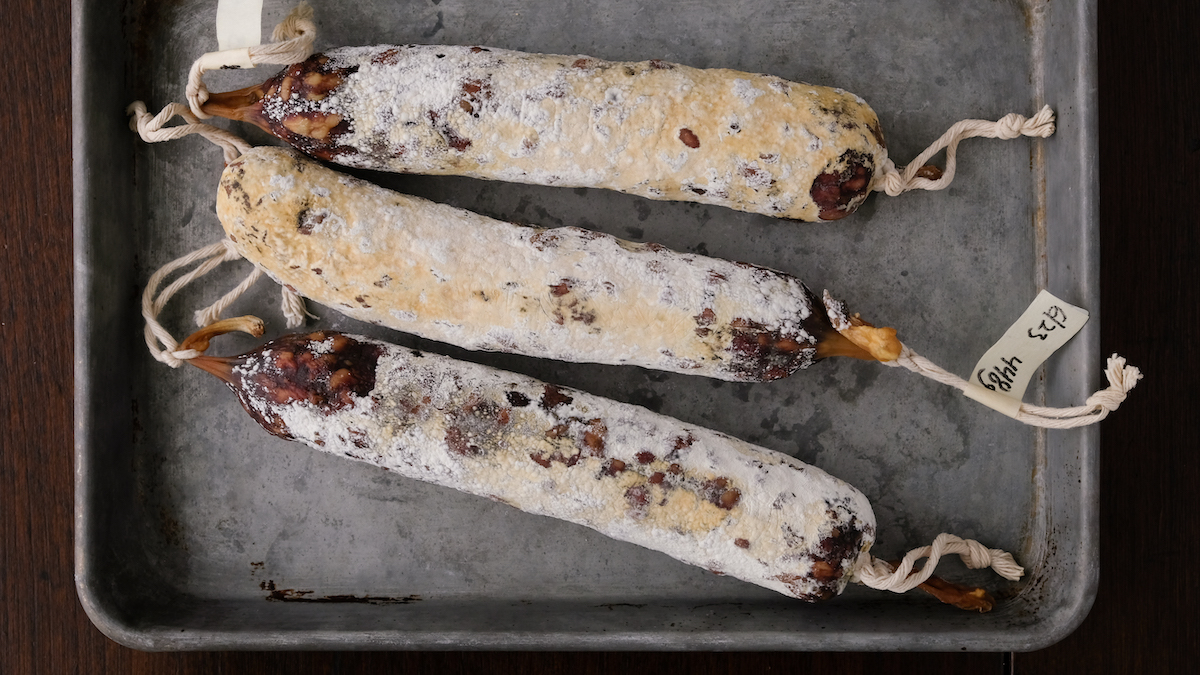
Cook time
-
Course
Preserves
Skill level
Advanced
At its core, making salami is all about high quality meat, time, salt, and fermentation. The process of curing and drying salami intensifies the existing flavors and qualities of the meat, which is why I believe wild game is the perfect protein for salami. Wild game has a depth of flavor that is unmatched by domestic meats.
Making salami is simple, yet specialized. The easiest way to describe the process goes like this: grind, season, inoculate with a culture, stuff, incubate, and dry.
If you process your own game, you probably have a lot of the necessary equipment for making salami. In addition to a meat grinder and sausage stuffer, you'll also need a curing chamber or room. This is nothing more than a clean environment that houses the correct temperature and humidity for curing salami. A refrigerator with extra temperature and humidity controls is ideal, but a cellar or similar space could also work if the temperature and humidity are consistent. You want the temperature to be 52 to 55 degrees Fahrenheit and the humidity at around 75%.
If you’re planning on using a cellar or closet space for this, keep in mind that seasonal shifts in temperature and humidity can affect your curing environment. A basement that has ideal conditions in January might be too warm for curing in July. You can get this information and ensure your curing space is suitable by using a thermometer and hygrometer.
You'll also need starter cultures which will kick-start the fermentation process. Many specialty food retailers sell them online. Some starter cultures need a warm environment to get going initially. This stage, known as incubation, usually requires higher heat and humidity than what you might have in your curing chamber. You may want to assemble a small incubation chamber if you don’t have the right conditions for incubation in your home.
Instacure #2 (prague powder #2) is a requirement, as is the use of dextrose, and there are no acceptable substitutes from a food safety standpoint. You need the long term effects of the sodium nitrate in the Instacure, and the starter culture will only react with certain types of sugar. Both the starter culture and the Instacure work together to prevent the growth of pathogenic bacteria like Clostridium botulinum. Botulism is a serious and potentially fatal disease, although rare if best practices are followed. For this reason, the amount of salt, dextrose, and cure are extremely important. To ensure consistency and accuracy of measurement, salami recipes are best measured by weight instead of volume.
As for selecting meat for salami, I recommend using roasts or large pieces of trim, free of excessive connective tissue. Proper field care and storage is paramount for the meat prior to making your salami. The quality of the meat will only be compounded by the curing process, and any off-flavors will be amplified.
This recipe is a classic fennel salami, minimal on the aromatics. The fennel and garlic compliment the venison, but the meat is the star of the show.

Ingredients
- 70% venison and 30% pork fat, trimmed and cubed
- 2.5% salt
- 0.25% Instacure #2
- 0.25% black pepper, crushed fine
- 0.5% dextrose
- 0.75% fennel seed, toasted, crushed
- 1.5% fresh garlic, minced
- 3% red wine
- Bactoferm f-rm-52
- Beef middles or pork casing
Also works with
Special equipment
Preparation
- Trim and cube venison and pork fat small enough to go through the grinder. You want approximately a 70:30 ratio of venison to pork fat. Place the meat and fat on a scale and record the weight in grams. Make sure to use the tare function on your scale to exclude the weight of the container.
- Use the weight of the meat to calculate the amount of the remaining ingredients you need. For example, if you are working with 1000 grams of meat and fat, you'll need 25 grams of salt, and so forth. This method sounds fussy, but is very simple once you get the hang of it, and it allows you to work with any amount of meat you want, without having to scale annoying measurements like ¼ teaspoons up or down.
- Combine meat and fat with salt, Instacure #2, dextrose, pepper, fennel, and garlic. Cover and refrigerate overnight, then grind the mixture through a fine die, about 4.5 millimeters.
- Prepare bactoferm f-rm-52 according to manufacturer instructions.
- Using a stand mixer or wooden spoon, mix the ground meat with wine. Add the bactoferm and water mixture. Mix until slightly tacky, about 1 to 2 minutes.
- Stuff into beef middles or pork casings, tie into 10" links, and prick with a sterile needle or sausage pricker. Weigh and record the starting weight of each set of links. I like to write the starting weight on masking tape wrapped around the twine I will use to hang the links.
- Incubate for about 12 to 18 hours in a warm room, then hang in the cure chamber for 21 to 40 days, or until 30% to 35% weight loss is achieved.
Sign In or Create a Free Account
Reviews
At its core, making salami is all about high quality meat, time, salt, and fermentation. The process of curing and drying salami intensifies the existing flavors and qualities of the meat, which is why I believe wild game is the perfect protein for salami. Wild game has a depth of flavor that is unmatched by domestic meats.
Making salami is simple, yet specialized. The easiest way to describe the process goes like this: grind, season, inoculate with a culture, stuff, incubate, and dry.
If you process your own game, you probably have a lot of the necessary equipment for making salami. In addition to a meat grinder and sausage stuffer, you'll also need a curing chamber or room. This is nothing more than a clean environment that houses the correct temperature and humidity for curing salami. A refrigerator with extra temperature and humidity controls is ideal, but a cellar or similar space could also work if the temperature and humidity are consistent. You want the temperature to be 52 to 55 degrees Fahrenheit and the humidity at around 75%.
If you’re planning on using a cellar or closet space for this, keep in mind that seasonal shifts in temperature and humidity can affect your curing environment. A basement that has ideal conditions in January might be too warm for curing in July. You can get this information and ensure your curing space is suitable by using a thermometer and hygrometer.
You'll also need starter cultures which will kick-start the fermentation process. Many specialty food retailers sell them online. Some starter cultures need a warm environment to get going initially. This stage, known as incubation, usually requires higher heat and humidity than what you might have in your curing chamber. You may want to assemble a small incubation chamber if you don’t have the right conditions for incubation in your home.
Instacure #2 (prague powder #2) is a requirement, as is the use of dextrose, and there are no acceptable substitutes from a food safety standpoint. You need the long term effects of the sodium nitrate in the Instacure, and the starter culture will only react with certain types of sugar. Both the starter culture and the Instacure work together to prevent the growth of pathogenic bacteria like Clostridium botulinum. Botulism is a serious and potentially fatal disease, although rare if best practices are followed. For this reason, the amount of salt, dextrose, and cure are extremely important. To ensure consistency and accuracy of measurement, salami recipes are best measured by weight instead of volume.
As for selecting meat for salami, I recommend using roasts or large pieces of trim, free of excessive connective tissue. Proper field care and storage is paramount for the meat prior to making your salami. The quality of the meat will only be compounded by the curing process, and any off-flavors will be amplified.
This recipe is a classic fennel salami, minimal on the aromatics. The fennel and garlic compliment the venison, but the meat is the star of the show.

Ingredients
- 70% venison and 30% pork fat, trimmed and cubed
- 2.5% salt
- 0.25% Instacure #2
- 0.25% black pepper, crushed fine
- 0.5% dextrose
- 0.75% fennel seed, toasted, crushed
- 1.5% fresh garlic, minced
- 3% red wine
- Bactoferm f-rm-52
- Beef middles or pork casing
Also works with
Special equipment
Preparation
- Trim and cube venison and pork fat small enough to go through the grinder. You want approximately a 70:30 ratio of venison to pork fat. Place the meat and fat on a scale and record the weight in grams. Make sure to use the tare function on your scale to exclude the weight of the container.
- Use the weight of the meat to calculate the amount of the remaining ingredients you need. For example, if you are working with 1000 grams of meat and fat, you'll need 25 grams of salt, and so forth. This method sounds fussy, but is very simple once you get the hang of it, and it allows you to work with any amount of meat you want, without having to scale annoying measurements like ¼ teaspoons up or down.
- Combine meat and fat with salt, Instacure #2, dextrose, pepper, fennel, and garlic. Cover and refrigerate overnight, then grind the mixture through a fine die, about 4.5 millimeters.
- Prepare bactoferm f-rm-52 according to manufacturer instructions.
- Using a stand mixer or wooden spoon, mix the ground meat with wine. Add the bactoferm and water mixture. Mix until slightly tacky, about 1 to 2 minutes.
- Stuff into beef middles or pork casings, tie into 10" links, and prick with a sterile needle or sausage pricker. Weigh and record the starting weight of each set of links. I like to write the starting weight on masking tape wrapped around the twine I will use to hang the links.
- Incubate for about 12 to 18 hours in a warm room, then hang in the cure chamber for 21 to 40 days, or until 30% to 35% weight loss is achieved.







